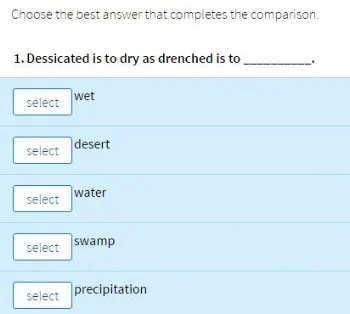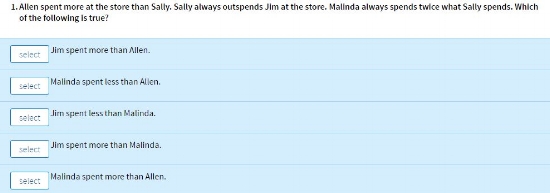Printable HSPT Practice Test PDFs: 5 Downloadable Tests
/The High School Placement Test (HSPT) has been used by high schools for over fifty years to assist with admissions, scholarship selection, and curriculum placement. The test is especially common at private schools and is a popular placement exam at Catholic high schools in particular.
The HSPT is a challenging assessment that requires students to answer many questions in a short amount of time. To help you prepare, we’re providing a HSPT practice test PDF, which you can download below by clicking the button. In addition, you will also receive a bonus document "5 Proven Test Prep Strategies for Using Practice Tests" to help you develop a study plan.
HSPT Practice Test
There is a lot to learn about the HSPT. So let's get started!
HSPT Basics
The High School Placement Test (HSPT) is a multiple-choice exam that is divided into five parts:
Schools also have the option of administering subtests in Mechanical Aptitude, Science, and Catholic Religion, but most schools do not include the optional subtests.
In total, students are given 2 hours and 30 minutes to complete 298 questions. This means that students have an average of 30 seconds per question, so it’s especially important to become familiar with test structure and content prior to the day of the assessment.
In the following sections, we’ll explore each of the five components of the HSPT and discuss test prep tips to help you conquer the HSPT.
HSPT Verbal
The HSPT Verbal section consists of five question types:
These questions assess your vocabulary skills and verbal logic.
Synonym and Antonym questions provide a word and ask you to select the answer choice that is closest in meaning or most opposite in meaning to the provided word.
There are two types of Analogy questions. Some questions provide a pair of words that are somehow related, as well as a third word. These questions ask you to select the answer choice that relates to the third word in the same way the first pair of words is related.
HSPT Practice Test - Analogy Question - Sample 1
Other Analogy questions give you a pair of words and ask you to select the pair of words that has the same relationship as the provided pair.
HSPT Practice Test - Analogy Question - Sample 2
Logic Questions test your ability to understand and apply logical statements, as in the example below:
HSPT Practice Test - Logic Question - Sample
Verbal Classification questions present you with a series of words and phrases. You must determine how all but one of the words are related and select the word that does not belong with the other choices.
HSPT Practice Test - Verbal Classification Question - Sample
The Verbal section contains 60 questions and has a 16-minute time limit.
These questions are unique, so it’s very important to familiarize yourself with this question type by practicing beforehand. The HSPT Practice Test PDFs are a great resource to help you study.
You can also try reading more frequently to help improve your vocabulary. Vocabulary flashcards are another study option, and you can spend time learning about roots, prefixes, and suffixes that can help you infer the meaning of unfamiliar words.
Simply answering practice questions, however, will help you learn vocabulary that may appear on the HSPT.
HSPT Quantitative
The Quantitative section of the HSPT is divided into four question categories:
Number Seriesquestions present a series of numbers, and you’re asked to determine which number must come next to logically follow the pattern.
HSPT Practice Test - Number Sequence Question - Sample
To answer Number Manipulation questions, you have to solve a sequence of calculations to arrive at the correct answer.
HSPT Practice Test - Number Manipulation Question - Sample
Geometric and Non-Geometric Comparisons ask you to compare quantities that are or are not geometrically-determined values.
The Quantitative section includes a total of 52 questions and students are given 30 minutes to answer them.
Simply learning grade-level mathematics throughout the school year will help you prepare for HSPT Quantitative Reasoning. Pay particular attention to relationships and comparisons between numbers.
For more sample questions or to get extra practice with these question types, check out the HSPT Practice Test PDFs.
HSPT Reading is a fairly standard Reading Comprehension assessment. You read both literary and informational passages and answer multiple-choice comprehension questions. There are no short answer or essay questions on the HSPT.
Questions may ask you to find main idea, select the answer choice that best summarizes the passage, compare and contrast ideas within the passage, make inferences based on the information in the passage, determine author’s purpose, etc.
HSPT Practice Test - Main Idea Question - Sample
You may also be asked to answer fill-in-the-blank questions that demonstrate your basic understanding of the information in the passage.
HSPT Practice Test - Reading Fill in the blank Question- Sample
Students are given 25 minutes to complete 62 Reading questions.
Although the HSPT Reading test does not ask extremely advanced questions, you will need to practice your pacing to ensure that you don’t run out of time. Time yourself completing practice sections on the HSPT Practice Test PDFs to see if you need to adjust your test-taking strategy.
Reading more frequently can also help you with this section of the test, because you will improve both your speed and your comprehension abilities.
The HSPT Mathematics section is the longest section on the test. While the Quantitative section focuses on mathematical logical, the Mathematics section assesses grade level appropriate mathematical skills, knowledge, and computation.
There are two types of questions: Concepts and Problem-Solving. Concept questions are short, direct questions that ask students to demonstrate knowledge of a single mathematical concept.
HSPT Practice Test - Math Concept Question - Sample
Problem-Solving questions are typically word problems that combine two or more math concepts.
HSPT Practice Test - Math Problem Solving Question - Sample
In total, there are 64 questions on the Math test. 24 are Concept questions, while the other 40 assess Problem-Solving. Students have 45 minutes to complete the section.
You may not use a calculator on any portion of the HSPT exam.
The HSPT includes 60 Language Skills questions that focus on grammar, spelling, punctuation, capitalization, usage, and sentence structure.
Many questions will ask you to recognize and correct errors in sentences, either by selecting the correct way to word the sentence or by indicating what type of error has occurred in the sentence.
HSPT Practice Test - Language 1 Question- Sample
HSPT Practice Test - Language 2 Question - Sample
You may be asked to order sentences logically and to select topic sentences, concluding sentences, and irrelevant sentences.
You will be given 25 minutes to complete this section.
Yet again, reading can help you improve your score on this section, as you will begin to recognize errors and illogical sentences. By practicing Language questions, you will also increase your recognition of errors that are commonly tested on the HSPT.
If you feel that you need practice with the Language Skills section, you can find many more sample questions in the HSPT Practice Test PDFs.
The most important piece of information about HSPT scoring is that there is no penalty for incorrect answers. This means that you should answer each and every question on the test, even if you bubble in some last-minute guesses.
Running out of time is a common problem on the HSPT, but you can potentially increase your score if you at least fill in a bubble for every question before time runs out.
You are given one point for each correctly answered question. This tally is known as your raw score. This number is then converted into a scaled score that compensates for any difference between test versions.
HSPT scaled scores range from 200-800. The average standard score is 500. What exactly is a good scaled score on the HSPT?
That question is difficult to answer, because each school or program sets their own standards for the HSPT. It is best to call the school you’re applying to and ask about score requirements for the HSPT.
Once your scaled score is determined, you also get a percentile rank that compares your performance to other student performances across the nation.
A percentile rank ranges from 1-99. For example, if you score in the 85th percentile, you scored equal to or higher than 85% of test-takers.
Your score report will also indicate your national percentiles for Total Cognitive Skills (a total of your Verbal Skills and Quantitative Skills) and Total Basic Skills (a total of your Reading, Mathematics, and Language scores).
Additionally, you will receive a Cognitive Skills Quotient which is similar to an IQ score. The average CSQ is 100, and your age is factored into this score.
The Grade Equivalents on your score report show the grade and month that correspond to your test performance for each skill level. This will tell you if you appear to be performing below, above, or on grade level.
As you can see, the HSPT score report helps you understand your areas of strength and weakness. This gives you information about what academic skills you need to focus on in the future in order to continue improving.
We’ve scattered some test prep tips throughout this article, so let’s do a quick recap:
We’ve mentioned that the HSPT Practice Test PDFs are a great tool to help you practice HSPT test questions prior to test day.
Take the time to analyze your answers. If you miss a question, figure out why the correct answer is right and develop a better approach to this question type to use in the future.
Once you become more confident with test content, begin timing yourself to see if you will need to speed up in order to complete the test.
Also keep in mind that there is no penalty for incorrect answers, so if you do run out of time on test day, spend the last couple of minutes filling in an answer for every bubble on your answer sheet.
Because the time limit is so tight on HSPT, be sure to answer easy questions first. If a question is giving you too much trouble, skip it and come back to it later, once you’ve picked up some faster, easier points.
If you follow these tips and use the HSPT Practice Test PDFs to your advantage, we’re confident that you’ll perform your best on the High School Placement Test.














